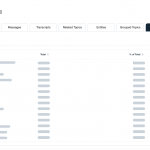5 steps to supercharge your customer service with contextual intelligence
5 steps to supercharge your customer service with contextual intelligence

According to Magnus Geverts at Calabrio, exceptional customer experience goes beyond connecting the dots between different channels. It’s all about understanding and anticipating a customer’s every need. Here are five steps to building a contextual customer service.
Retail eCommerce continues to flourish and growing consumer confidence in mobile technology is fuelling mobile commerce. According to the digital market research company eMarketer, mCommerce sales in the UK are quickly approaching half of the country’s retail eCommerce market. By 2021, purchases made online via mobile devices will account for 51.7% of total retail eCommerce sales, up from 43.3% in 2017.
What makes this particularly interesting is that the nature of mobile devices means that businesses potentially have the opportunity to know more about their customers than ever before. GPS-enabled smartphones allow organizations to see where their customers are. They also know if a customer has been browsing a mobile website or app and use that information to understand what the customer might need in the future. QR (quick response) codes on products automate and accelerate a two-way interaction. Customers retrieve all the information they need quickly while organizations have the intelligence they require to direct customers to the correct place within their self-service function to complete the final purchase.
It’s a trend contact center analyst ContactBabel calls ‘The Great Mobile Opportunity’ (The UK Contact Centre Decision-Makers’guide 2018/2019) and it has the power to revolutionize customer service and the role of the contact center. So how do organizations make the most of this mobile data to take customer service to the next level?
The end of reactive contact centers
Contextual communication is the next step up from omni-channel in the contact center, as Vasili Triant at Cisco has been promoting at our collaborative events. Firstly customer service should be fully optimized for mobility. Then digest what’s being said on social media and listen to conversations that consumers commonly conduct using apps on their mobile devices using Apple Business Chat, Facebook Messenger, Snapchat, Instagram or Twitter. Then, use this valuable intelligence by putting it into context for the customer.
The challenge is that most customer services are reactive. Someone contacts the customer service and an employee looks up various pieces of information to solve a specific enquiry at a particular period in time. No account is taken of contextual factors that predetermine the outcome of customer interactions.
Five steps to the contextual customer service
It’s time to move away from a reactive customer service and exploit your data. Drawing on the great insights from Vasili, you can achieve this in the following ways:
1. Be contextual
Take data and apply intelligence to it. Give employees the context of why a customer is contacting you in the first place. If a customer has spent the last 30 minutes with technical support without success, make this information available to prepare the employee. A greeting that reflects empathy such as, “Hi Joe, I understand you’ve been talking to tech support but it looks like you still haven’t got the answer you need, let me help you…” will go a long way towards calming potentially inflammatory interactions.
2. Be suggestive
Use the data you already have to suggest certain types of interaction with customers. For example, seeing that a customer has left your website and looked at another brand is not the end but a great opportunity to reel them back in with a response like: “I see that you’ve had a problem with your current car how can we help you by putting you on a special trade-in program with a 3-year free warranty?”
3. Be pre-emptive
Based on previous interactions, a customer’s preferred communication method can be determined, so use this information to pre-empt how to deal with them the next time around, for example “I see you’ve been on our website, would you prefer me to give you a call on the following number?”
4. Be predictive
You know that a customer has bought a pair of shoes from your fashion department but did you know they also purchased a sofa from homewares? Make sure your data and processes are consistent and sufficiently integrated to facilitate joined-up customer responses along with the opportunity to cross-sell and up-sell other products and services.
5. Contextualize the workforce
Contextualize the workforce by deploying the latest cloud Workforce Management (WFM) solutions. Use them to create a ‘go-to’ place for all your talents and resources and identify the employees who have the highest levels of emotional intelligence to add context and real value to customer interactions. Give employees real-time help with unified systems that allow them to see when expert help is available across the organization then maximize WFM data to ensure the customer is put through to the right employee, right away.
If you change the reactive to contextual, suggestive, pre-emptive and predictive, both employees and customers will benefit from a superior experience. Think about contextual as the new supercharged omni-channel.









